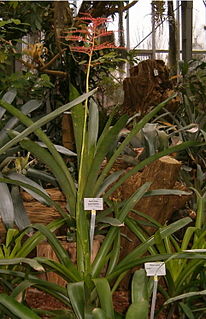
An IUCN Red List Critically Endangered species is one that has been categorized by the International Union for Conservation of Nature as facing an extremely high risk of extinction in the wild. As of 2021, of the 120,372 species currently tracked by the IUCN, there are 8,404 species that are considered to be Critically Endangered.

Racinaea is a genus of the flowering plants in the family Bromeliaceae, subfamily Tillandsioideae. The genus is named for Racine Foster, wife of Mulford B. Foster and co-founder of the BSI.

Ronnbergia wuelfinghoffii is a species of flowering plant in the family Bromeliaceae, native to western Colombia and Ecuador. It was first described in 1998 as Aechmea wuelfinghoffii. Its natural habitat is subtropical or tropical moist lowland forests. It is threatened by habitat loss.
Iresine chrysotricha, synonym Irenella chrysotricha, is a species of plant in the family Amaranthaceae. It is endemic to Ecuador. Its natural habitats are subtropical or tropical dry forests and subtropical or tropical moist lowland forests. It is threatened by habitat loss.
Gregbrownia brownii, synonym Mezobromelia brownii, is a species of flowering plant in the family Bromeliaceae. It is endemic to Ecuador. Its natural habitats are subtropical or tropical moist montane forests and subtropical or tropical high-altitude shrubland. It is threatened by habitat loss.
Pitcairnia carnososepala, synonym Pepinia carnososepala, is a species of flowering plant in the family Bromeliaceae, endemic to Ecuador. It was first described by in 1987. Its natural habitats are subtropical or tropical moist lowland forests and subtropical or tropical moist montane forests. It is threatened by habitat loss.
Pitcairnia harrylutheri is a species of flowering plant in the family Bromeliaceae, endemic to Ecuador. It was first described by Harry Edward Luther in 1991 as Pepinia fulgens. When transferred to the genus Pitcairnia in 1999, the epithet had to be changed, as the name Pitcairnia fulgens had already been used. Pitcairnia harrylutheri is a replacement name. The natural habitats of the species are subtropical or tropical moist lowland forests and subtropical or tropical moist montane forests. It is threatened by habitat loss.
Pitcairnia harlingii is a species of flowering plant in the family Bromeliaceae, endemic to Ecuador. It was first described by Lyman Bradford Smith in 1961. Its natural habitats are subtropical or tropical moist lowland forests and subtropical or tropical moist montane forests. It is threatened by habitat loss.
Pitcairnia elvirae, synonym Pepinia verrucosa, is a species of flowering plant in the family Bromeliaceae, endemic to Ecuador. It was first described in 1999. Its natural habitats are subtropical or tropical moist lowland forests and subtropical or tropical moist montane forests. It is threatened by habitat loss.
Racinaea hauggiae is a species of plant in the family Bromeliaceae. It is endemic to Ecuador. Its natural habitats are subtropical or tropical moist montane forests and subtropical or tropical high-altitude shrubland. It is threatened by habitat loss.
Racinaea quadripinnata is a species of plant in the family Bromeliaceae. It is endemic to Ecuador. Its natural habitats are subtropical or tropical moist montane forests and subtropical or tropical high-altitude shrubland. It is threatened by habitat loss.
Racinaea tandapiana is a species of plant in the family Bromeliaceae. It is endemic to Ecuador. Its natural habitat is subtropical or tropical moist montane forests. It is threatened by habitat loss.
Racinaea tripinnata is a species of plant in the family Bromeliaceae. It is endemic to Ecuador. Its natural habitats are subtropical or tropical moist montane forests and subtropical or tropical high-altitude shrubland. It is threatened by habitat loss.
Racinaea blassii is a species of plant in the family Bromeliaceae. It is endemic to Ecuador. Its natural habitat is subtropical or tropical moist montane forests. It is threatened by habitat loss.
Racinaea euryelytra is a species of plant in the family Bromeliaceae. It is endemic to Ecuador. Its natural habitat is subtropical or tropical high-altitude shrubland. It is threatened by habitat loss.
Racinaea inconspicua is a species of plant in the family Bromeliaceae. It is endemic to Ecuador. Its natural habitat is subtropical or tropical moist montane forests. It is threatened by habitat loss.
Racinaea pseudotetrantha is a species of plant in the family Bromeliaceae. It is endemic to Ecuador. Its natural habitat is subtropical or tropical dry forests. It is threatened by habitat loss.
Racinaea sinuosa is a species of plant in the family Bromeliaceae. It is endemic to Ecuador. Its natural habitats are subtropical or tropical moist lowland forests and subtropical or tropical moist montane forests. It is threatened by habitat loss.
Lemeltonia acosta-solisii is a species of plant in the family Bromeliaceae. It is endemic to Ecuador. Its natural habitats are subtropical or tropical moist lowland forests and subtropical or tropical moist montane forests. It is threatened by habitat loss.
Tillandsia portillae is a species of flowering plant in the family Bromeliaceae, endemic to Ecuador. It was first described in 1997. Its natural habitat is subtropical or tropical moist montane forests. It is threatened by habitat loss.




